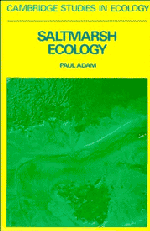Book contents
- Frontmatter
- Contents
- Preface
- Abbreviations for frequently-occurring species names
- 1 General features of saltmarshes and their environment
- 2 The saltmarsh biota
- 3 Variation in saltmarsh vegetation
- 4 Coping with the environment
- 5 Plant life history studies
- 6 Saltmarshes as ecosystems
- 7 Modification, management and conservation
- References
- Index
3 - Variation in saltmarsh vegetation
Published online by Cambridge University Press: 04 April 2011
- Frontmatter
- Contents
- Preface
- Abbreviations for frequently-occurring species names
- 1 General features of saltmarshes and their environment
- 2 The saltmarsh biota
- 3 Variation in saltmarsh vegetation
- 4 Coping with the environment
- 5 Plant life history studies
- 6 Saltmarshes as ecosystems
- 7 Modification, management and conservation
- References
- Index
Summary
Introduction
Saltmarshes are found on many of the world's coasts and experience a wide range of environmental conditions.
There is a tendency, however, to regard all saltmarshes as being very similar and to base broad generalisations on the results of studies of particular sites. It is important to be aware of the variability of saltmarshes if generalisations about their ecology are to be sustained.
In this chapter variation in saltmarsh vegetation at various spatial scales is discussed. After a broad-brush account of global variation, the saltmarshes of Britain and temperate Europe are discussed in detail and some factors which might be responsible for variation between sites are explored.
The extent to which other attributes, particularly those related to ecosystem functions, co-vary with the flora and vegetation remains to be documented.
Patterns of variation
Although in certain features there are resemblences between all saltmarshes, there are also major differences. Frey & Basan (1985) suggest that differences between saltmarshes are related to eight factors:
(1) Nature of the local marsh flora (and fauna);
(2) Effects of climate, hydrology and soil factors on the flora;
(3) Availability, composition, mode of deposition and compaction of sediments;
(4) Organism–substrate interrelationships;
(5) Topography and areal extent of the depositional surface;
(6) Tidal range;
(7) Wave and current energy; and
(8) Tectonic and eustatic stability of the coastal area.
- Type
- Chapter
- Information
- Saltmarsh Ecology , pp. 146 - 206Publisher: Cambridge University PressPrint publication year: 1990



